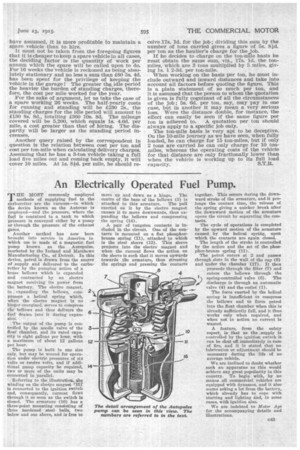An Electrically Operated Fuel Pump.
Page 27

If you've noticed an error in this article please click here to report it so we can fix it.
THE MOST commonly employed methods of supplying fuel to the carburetter are the vacuum—in which the device known as the Autovac is employed—and the pressure, where the fuel is contained in a tank to which pressure is conveyed either by a pump or through the pressure of the exhaust gases.
• Another method has now been brought into service in America in which use is made of a magnetic fuel pump known as the Autopulse, marketed by the Ireland and Matthews Manufacturing Co., of Detroit. In this device, petrol is drawn from the source of supply and delivered to the carburetter by the pumping action of a brass bellows which is expanded and contracted by an electro magnet receiving its power from the battery. The electro magnet, in expanding the bellows, compresses a helical spring which, when the electro magnet is no longer energized, serves to compress thebellows and thus delivers the fuel drawn into it during expanBien.
The output of the pump is controlled by _the needle valve of the float chamber, and its rated capacity is eight gallops per hour, with a maximum of about 12 gallons per hour.
The pump is built in one size only, but may be wound for operation under electric pressures of six volts or twelve volts, and if additional pump capacity be required, 14 two or more of the units may be 2
12 connected in parallel.
'Referring to the illustration, thit winding on the electro magnet fle) is connected to the ignition switch and, consequently, current flows through it so soon as the switch is closed. The armature (10) has a three-point mounting consisting of three hardened steel balls, two below and one above, and is free to move up and down as a hinge. The centre of the base of the bellows (8) is attached to this armature. The pull exerted on it by the electro magnet causes it to move downwards, thus expanding the bellows and compressing the spring (14).
A pair of tungsten contacts is included in the circuit. One of the contacts is mounted on a flat phosphorbronze spring (11), attached to which is the steel sleeve (12). This sleeve projects into the electro magnet and when the current flows the action on the sleeve is such that it moves upwards towards the armature, thus stressing the springs and pressing the contacts
together. This occurs during the downward stroke of the armature, and it prolongs the contact time, the release of the spring giving a quicker break after the downward motion of the armature opens the circuit by separating the contacts.
The cycle of operations is completed by the upward motion of the armature caused by the helical spring, upon which the contacts are again closed.
The length of the stroke is controlled by the action and the set of the phosphor-bronze spring (11).
The petrol enters at 2 and passes through ,slots in the wall of the cap (8) and under the chamber (17). It then proceeds through the filter. (7) and enters the bellows through the spring-controlled valve (6). •The discharge is through an automatic valve. (4) and the outlet (1).
The force exerted by the helical spring is insufficient to compress the bellows and to force petrol into the float chamber when this is already sufficiently full, and it thus works only when required, and when not in action no current is wasted.
A feature, from the safety aspect, is that as the supply is controlled by the ignition switch it can be shut off immediately in case of fire, and it is stated that no lubrication or adjustment should be necessary during the life of an average vehicle.
We are inclined to doubt whether
such an apparatus as this would achieve any great popularity in this country. To begin with, by no means all commercial vehicles are equipped with dynamos, and it also seems asking a lot from the battery, which already has to cope with starting and lighting and, in some cases, with ignition also.
We are indebted to Motor Age for the accompanying details and illustrations.






























